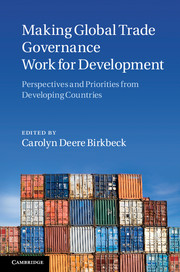 Making Global Trade Governance Work for Development
Making Global Trade Governance Work for Development outstanding challenges and governance implications
from Part III - Strengthening multilateralism
Published online by Cambridge University Press: 07 September 2011
Since its inception in 1995, the dispute settlement system of the World Trade Organization (WTO) has provided WTO Members with a successful system of third-party adjudication of intergovernmental disputes. However, the success of the system is not unqualified, especially with respect to the engagement of developing and least developed countries in the system.
There is considerable debate as to whether developing countries are maximizing the opportunities to advance their trade interests provided by the system. This chapter will briefly explain the system and discuss how developing countries have made increasing use of it. It begins by describing the main features of the WTO system, how it applies to developing countries and what special treatment is available to developing countries under the system. It reviews the participation of developing countries in the system since 1995 and discusses the role the Advisory Centre on WTO Law (ACWL) has played in fostering developing and least developed country engagement in the system. The chapter summarizes the ongoing challenges facing developing countries in WTO dispute settlement proceedings, including the complexity of the process, their lack of resources, the lack of public–private sector partnerships, the disuse of alternative mechanisms and the fear of retaliation. Finally, the chapter evaluates some of the alternative mechanisms and proposals to assist developing countries in utilizing the dispute settlement system to the full and concludes that improvements can be made both in streamlining the system itself and in increasing the capacity of developing countries to engage in the system.
To save this book to your Kindle, first ensure no-reply@cambridge.org is added to your Approved Personal Document E-mail List under your Personal Document Settings on the Manage Your Content and Devices page of your Amazon account. Then enter the ‘name’ part of your Kindle email address below. Find out more about saving to your Kindle.
Note you can select to save to either the @free.kindle.com or @kindle.com variations. ‘@free.kindle.com’ emails are free but can only be saved to your device when it is connected to wi-fi. ‘@kindle.com’ emails can be delivered even when you are not connected to wi-fi, but note that service fees apply.
Find out more about the Kindle Personal Document Service.
To save content items to your account, please confirm that you agree to abide by our usage policies. If this is the first time you use this feature, you will be asked to authorise Cambridge Core to connect with your account. Find out more about saving content to Dropbox.
To save content items to your account, please confirm that you agree to abide by our usage policies. If this is the first time you use this feature, you will be asked to authorise Cambridge Core to connect with your account. Find out more about saving content to Google Drive.